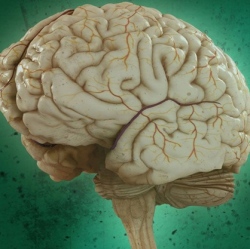
Described in a paper published in Nature, Neuropixels probes represent a significant advance in neuroscience measurement technology, and will allow for the most precise understanding yet of how large networks of nerve cells coordinate to give rise to behavior and cognition, according to the researchers.
Neuropixels probes are similar to electrophysiology probes that neuroscientists have used for decades to detect extracellular electrical activity in the brains of living animals — but they incorporate two critical advances:
The new probes are thinner (70 x 20 micrometers) than a human hair, but about as long as a mouse brain (one centimeter), so they pass through and collect data from multiple brain regions at the same time. The 960 electrical sensors and recording electrodes are densely packed along their length, recording hundreds of well-resolved single neuron signal traces, making it easier for researchers to pinpoint the cellular sources of brain activity.
Each of the new probes incorporates a nearly complete recording system — reducing hardware size and cost and eliminating hundreds of bulky output wires.
These features will allow researchers to collect more meaningful data in a single experiment than current technologies (which can measure the activity of individual neurons within a specific spot in the brain or can reveal larger, regional patterns of activity, but not both simultaneously).
To develop the probes, researchers at HHMI’s Janelia Research Campus, the Allen Institute for Brain Science, and University College London worked with engineers at imec, an international nanoelectronics research center in Leuven, Belgium, with grant funding from the Gatsby Charitable Foundation and Wellcome.
Accelerating neuroscience research
With nearly 1,000 electrical sensors positioned along a probe thinner than a human hair but long enough to access many regions of a rodent’s brain simultaneously, the new technology could greatly accelerate neuroscience research, says Timothy Harris, senior fellow at Janelia, leader of the Neuropixels collaboration. “You can [detect the activity of] large numbers of neurons from multiple brain regions with higher fidelity and much less difficulty,” he says.
There are currently more than 400 prototype Neuropixels probes in testing at research centers worldwide.
“At the Allen Institute for Brain Science, one of our chief goals is to decipher the cellular-level code used by the brain,” says Christof Koch, President and Chief Scientist at the Allen Institute for Brain Science. “The Neuropixels probes represent a significant leap forward in measurement technology and will allow for the most precise understanding yet of how large coalitions of nerve cells coordinate to give rise to behavior and cognition.”
Neuropixels probes are expected to be available for purchase by research laboratories by mid-2018.
Scientists from the consortium will present data collected using prototype Neuropixels probes at the Annual Meeting of the Society for Neuroscience in Washington, DC, November 11–15, 2017.
